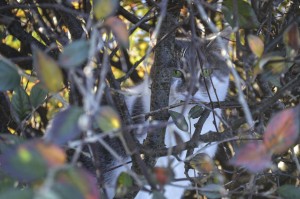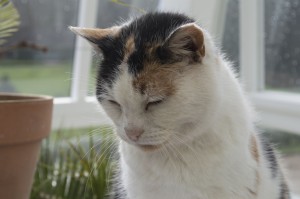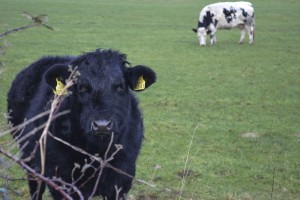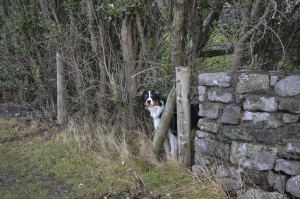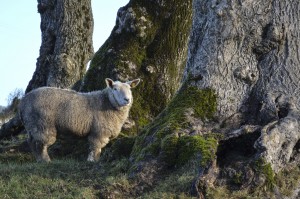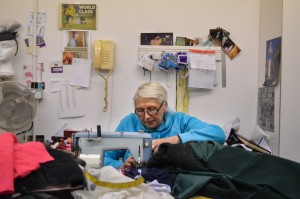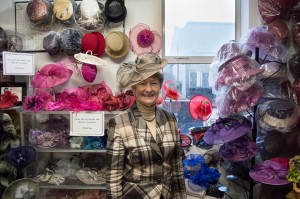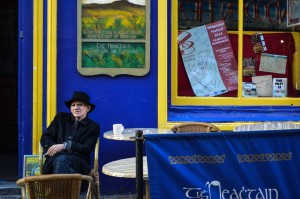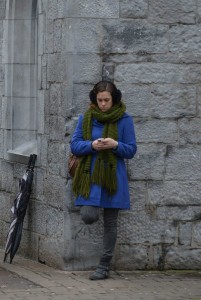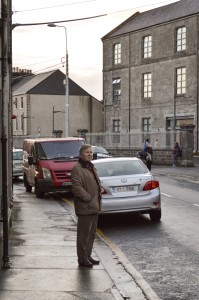The Spirit of Ireland
This place feels familiar, yet surreal. Like a dream half-forgotten. But just when it seems it has completely slipped away, sunken to the bottom of the sub-conscious sea where all forgotten things go, something is seen, a memory jogged, and it is reeled up quickly before it can disappear forever. In a rush of excitement it comes bursting like a cork from a Champaign bottle, a flood of elapsed thoughts and memories. And just like suddenly remembered dreams, everything seems more magical: the colors brighter, the smells sweeter, the food tastier. In that one fleeting moment the entire land rushes past.
Step outside and find that here there is a drizzly dampness that hangs in the air between one swift, hammering shower and the next. It’s the kind of dampness that dews skin, frizzes hair, and moistens clothes; yet the showers and the dampness are what make the soaring, tumbling hills gleam emerald when the sun forces it’s way through the hazy fog. That luscious, glimmering green embraces all that surrounds it. It worms its way between the cracks in the stones of the ancient, crumbling castle towers that dot the land like checkers on a checker board. It twists and climbs over the low, ageless stone walls that stand as divisions between roads and fields and farmers’ lands. Some of the walls house cows who roam about grating the shimmering green grass or the dry, stringy hay between their great block teeth; others are home to the fluffy woolen sheep that mirror the gray and white clouds above; some seem to hold nothing but endless meadows or fields of limestone or twiggy, spiny hazel bushes.
Stop. Stare at the walls and feel those that reside in life. Built stone upon stone until we are all divided, separated, categorized, and kept in our place.
Gaze up over the low walls, and see the towering hills that surround the low fertile valley. Halfway up the grass starts to thin and the trees tapper off and the mountain-hills are capped in silver stones; boulders and pebbles and every size rock in between. Soar past the hills and come to the rocky shores scattered with forgotten shells and seaweed that drapes over the stones like the stringy hair of a severely balding man who is desperately trying to cling to what little remains of his youth. A rush, and the waves, glimmering, flashing blue, sliver, grey, turquoise, green, collapse over the shore and reclaim some of the shells they so carelessly threw out. Look up. The clouds above are white and fluffy, cotton balls glued to the sky. A little ways off there is a break and a majestic golden light streams down from the heavens above and dances on the sea below. Further still, the clouds start again, this time dark and heavy with a dense sheen of grey, made up of millions of droplets of water that blot out part of the horizon beyond.
Land on a cool grey stone and feel the slime of the seaweed that covers it. See the multitude of droplets and think of all the small troubles that drip-drop upon us till we are so sopping and laden with water that we sink into the sea. Thrash and fight against it until arms cramp and legs tire. Be still; ride with the waves and wash up upon the safety of the stone-covered beach.
Follow the rocky shore south and pass by small towns and villages; only a few hundred people or less reside there year round. When the summer breeze blows in it carries with it visitors from all around the globe, but in the cold winter months these places resemble ghost towns. The bed and breakfasts that line the street read “No Vacancies,” not because the rooms are full, but because they have been empty so long that the owners have decided its high time they take a vacation themselves. All the little sweater and chocolate shops, the kind that sell the touristy things, are boarded up, closed for the season. And when you happen upon a restaurant that will still open it’s doors in January there are but a few people scattered about it. Yet they aren’t like the spooky ghost towns seen in Scooby-Doo as a child. Rather these villages seem peaceful when they can be seen as they really are, without all the hustle and bustle of visitors from a far.
Don’t move. Listen. Hear the soft crashing of the distant waves, the caw of birdcalls, the whistle of the wind. Breathe in and let the cool sea air fill up empty lungs. Feel the contradiction of the rejuvenation and peace that the breeze brings.
Continue along the coast, it goes up and up for miles, always going up. Swear heaven is only a meter away and then the ground levels. Look along the coast or over the edge and all that can be seen are sheer cliffs and the irate waves that pound at them below. This high up, all that is to be heard is the crashing below like the beating of a hundred drums and the gusts of wind that shrill past like the soft notes of a lone penny-whistle. The cliffs stretch for miles, but only the first few can be made out, for the slowly setting sun dazzles and blinds and makes the sea mist glimmer gold all around it.
Turn back. Travel inland this time and pass by the old stone houses with thatched roofs and brilliantly colored doors; beside the cottage cows graze and sheep waddle. Low stone walls separate house from the road. They look as though the slightest breeze could bring them all toppling over, yet they stand and have stood for ages. Further on there is an old stone fort, or what is left of it. Grey jagged rocks jut out of the earth and form a ring, which holds another ring. Like the ancient, crumbling castle towers, these forts dot the land. Fairy forts, some call them. And while many of the people claim not to believe in all that superstitious mumbo-jumbo, very few would dare to destroy a fort for fear that the fairies will become their poltergeist. Go off the road and find paths that lead up, back into the hills. Twist and wind, up and up. The trees clear. The grass thins. Spin around and see it all: the fairy forts, the grassy pastures, the limestone fields, the thatched-roof cottages, the towering cliffs, the roaring sea, the low valley, the quaint villages, the homey pubs, the cheerful people. Step back. Try to see it all. Focus. Observe the small details, the way a soft mud splatters, the vibrancy of the leaves, the bright yellow of a cottage door. Commit the sights to memory. Clutch them close, so like a dream they can’t slip away.
Personal Narrative
Before we leave the school tells us we have to complete an online orientation; it consists of a bunch of slideshows that tell us what to expect while we’re abroad. Most people just flip through them and guess on the quiz at the end since the questions are so easy anyway. Not going to lie, I mostly did the same. But there were a few I read, either out of curiosity or a want to be prepared. They kept repeating how much culture shock I was going to go through. By the end I thought surely when I stepped off the plane in Dublin an ambulance would wee-woo up, strap me on a stretcher and cart me off to the hospital for I would be too culturally shocked to move. I also knew that this wouldn’t be covered by travelers insurance, just like bungee jumping and skydiving.
So there I was, prepared to be more shocked than I have been in a long while, since the time my dad accidentally bit my finger and I almost fainted. We land in Dublin, get off the plane, go through customs (how long is your stay? What will you be doing here?), and find our bus driver to take us to Ballyvaughan. My eyes drooping from jet lag, I’m awake enough to realize that, first of all, much of Ireland is actually made up of those stereotypical green hills and stone walls holding in herds of fluffy white sheep, and secondly, the biggest shock I’ve had so far is how much airplane food I can eat without feeling as though I’m going to hurl it all up at the slightest turbulence.
The bus zooms past the emerald hills, the low stone walls, the mooing cows, the baaing sheep, the big modern houses, the small traditional cottages, and arrives on the main street in the quaint village of Ballyvaughan. We park outside some of those traditional thatched-roof cottages; this is where we will be living for the next month. Some things are different; most are the same. I’ve never seen peat briquettes before, but they look an awful lot like a brick and a log had a baby so I figure they can’t be that hard to figure out. Plus you just have to get them to light on fire, and while this isn’t my personal area of expertise I’ve seen my dad and brother make a fire at our cabin oodles of times and it looks like a piece of cake. I’ve never had to use a dishwasher. In my family we just wash all our dishes by hand, so this is a luxury I’ve never dealt with. Since the warm water comes from a hot water tank, it only lasts so long. This I’m used to as well. We have the same thing at my house so I know that water doesn’t just come out of the faucet boiling hot by magic and if you’re last in line to shower it feels a lot like jumping into Lake Superior in December.
Over the next few days we get a tour of the college, which is very easy to navigate as there are only a few buildings, and begin our classes. The classrooms are familiar: bland white walls with only the windows to provide any ready distraction, squeaky fold-down lecture hall desks or hard plastic chairs and slightly wobbly tables. From the college it’s a few miles walk to our cottage. Robert comes in the van to pick us up in the morning and to bring us back home at night, but if you want to come early or stay late you have to walk. I do a lot more walking here than at home, but I don’t mind. To be honest I could use the exercise; I’m so perpetually hungry here that I snack more than I should. So I strap on my overly florescent, reflective, high-vis vest (who says you can’t be safe and fashionable?) and set out.
Many of the narrow roads are lined with trees whose emerald leaves reach high up to the heavens. Twisting, wrapping, and hugging the trunks are vines that sprout little leaves here and there and make it look as if the tree decided that it’s a bit too chilly out here and it’s high time he put on a sweater. And boy does he look dashing. Such a trendsetter that all the trees around start to follow and pretty soon they are all cloaked in nice green vine-sweaters. Every once in a while I’ll happen upon a spiky little fur tree and suddenly I feel quite at home. If I happen to see two or three I’d swear I was back in Minnesota.
When we travel to Galway we pass by many of the same rock walls and fields and hills and see the glimmer of Galway Bay. With a population of about eighty thousand it’s a small city by American standards but the biggest we’ve spent any time in during our travels around Ireland and just so happens to be about the same size as my hometown. I spend much of my time there wandering up and down shop street passing by the same colorful storefronts and somehow finding a new one every time. My mother likes antiques, so for her I stop into a little shop called Cobwebs. From the outside I see the dark interior and empty windows. It seems to be closed until I see a sign: “please visit our temporary shop upstairs.” So I do what the sign tells me to. There is a fashionable young woman working upstairs with blond spiky hair who explains that the shop flooded just a few weeks ago and they are working on repairing the floors. We start chatting. Where are you from? What brings you to Ireland? Typical conversational banter. When I explain that I’m here with my college and studying in the tiny village of Ballyvaughan she remarks that shortly after moving here from Philadelphia she worked as a server in Loges, a pub in the village that we had all come to know quite well.
What a shock to find how un-shocked I was. How marvelous to fly over seven different time zones and still fell welcomed and at home. The stark similarities and subtle differences mingle until I’m not really sure where I am anymore. Abroad? Home? Some strange limbo in between? And when I board the flight back home, land in frigid Minnesota, feel the bitter cold and compare my height to the snow banks, I’m going to have to wonder if I just arrived home or just left it.
